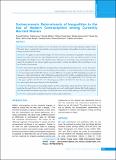Please use this identifier to cite or link to this item:
https://hdl.handle.net/20.500.14356/1187Full metadata record
| DC Field | Value | Language |
|---|---|---|
| dc.contributor.author | Pokhrel, Taranath | - |
| dc.contributor.author | Aryal, Kabita | - |
| dc.contributor.author | Adhikari, Ramesh | - |
| dc.contributor.author | Dulal, Bishnu Prasad | - |
| dc.contributor.author | Karki, Deepak Kumar | - |
| dc.contributor.author | Dahal, Harsha Raj | - |
| dc.contributor.author | Dangol, Milima Singh | - |
| dc.contributor.author | Poudel, Pradeep | - |
| dc.contributor.author | Bhattarai, Navaraj | - |
| dc.contributor.author | Lamichhane, Prabhat Lamichhane | - |
| dc.date.accessioned | 2023-05-02T07:49:41Z | - |
| dc.date.available | 2023-05-02T07:49:41Z | - |
| dc.date.issued | 2021 | - |
| dc.identifier.citation | PokhrelT., AryalK., AdhikariR., DulalB. P., KarkiD. K., DahalH. R., DangolM. S., PoudelP., BhattaraiN., & LamichhaneP. (2022). Socioeconomic Determinants of Inequalities in the Use of Modern Contraception among Currently Married Women. Journal of Nepal Health Research Council, 19(04), 705-711. https://doi.org/10.33314/jnhrc.v19i04.3738 | en_US |
| dc.identifier.issn | Print ISSN: 1727-5482; Online ISSN: 1999-6217 | - |
| dc.identifier.uri | http://103.69.126.140:8080/handle/20.500.14356/1187 | - |
| dc.description | Original Article | en_US |
| dc.description.abstract | Abstract Background: Despite interventions for over four decades, the unmet need for family planning is high in Nepal. This study aims to examine the status and the socioeconomic determinants of inequalities in modern contraception among currently married women. Methods: We applied a mixed-method design. We interviewed key informants for qualitative information and analyzed secondary data from the Nepal Multiple Indicator Cluster Survey, 2019, and different rounds of Nepal Demographic and Health Surveys. We calculated ratios, differences in percentages, and concentration indices to analyse the inequality. We ran a binary logistic regression model to estimate the adjusted effect of each factor on the use of modern contraception. Results: The richest-to-poorest difference in using modern contraception has decreased over 13 years. The richest-to-poorest difference decreased from 23.6 percentage points in 2006 to 13.3 percentage points in 2011 and further to 1.2 percentage points in 2016. The richest-to-poorest difference was negative in 2019, indicating poor people are using more contraception than the richest. Multivariate analysis showed the wealth is a significant predictor for using contraception. Women of richer households (aOR=1.29, 95% CI=1.13-1.48), middle (aOR=1.21, 95% CI=1.05-1.40), poorer (aOR=1.36, 95% CI 1.17-1.58) and poorest (aOR=1.18, 95% CI=1.05-1.34) were more likely to use contraception than women from the richest households. Conclusions: Poor people are increasingly using the modern contraception, and the gap between the poor and rich people has decreased. However, the trend of contraception use in each wealth quintile indicates that Nepal struggles to meet the sustainable development goal target of reducing the unmet need for family planning to less than 10% by 2030. Keywords: Contraception; inequalities; married women; nepal; wealth status. | en_US |
| dc.language.iso | en | en_US |
| dc.publisher | Nepal Health Research Council | en_US |
| dc.relation.ispartofseries | Oct-Dec, 2021;3738 | - |
| dc.subject | Contraception | en_US |
| dc.subject | inequalities | en_US |
| dc.subject | married women | en_US |
| dc.subject | nepal | en_US |
| dc.subject | wealth status | en_US |
| dc.title | Socioeconomic Determinants of Inequalities in the Use of Modern Contraception among Currently Married Women | en_US |
| dc.type | Journal Article | en_US |
| local.journal.category | Original Article | - |
| Appears in Collections: | Vol. 19 No. 04 (2021): Vol 19 No 4 Issue 53 Oct-Dec 2021 | |
Files in This Item:
| File | Description | Size | Format | |
|---|---|---|---|---|
| 3738-Manuscript-26778-1-10-20220313.pdf | Fulltext Download | 267.03 kB | Adobe PDF |  View/Open |
Items in DSpace are protected by copyright, with all rights reserved, unless otherwise indicated.
